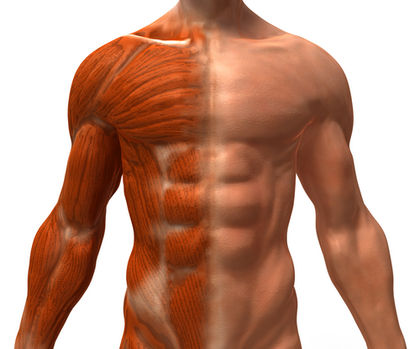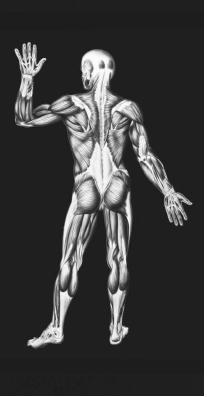Muscular system

The muscular system is the body's network of tissues that controls movement both of the body and within it (such as the heart's pumping action and the movement of food through the gut). Movement is generated through the contraction and relaxation of specific muscles.
The muscles of the body are divided into two main classes: skeletal (voluntary) and smooth (involuntary). Skeletal muscles are attached to the skeleton and move various parts of the body. They are called voluntary because a person controls their use, such as in the flexing of an arm or the raising of a foot. There are about 650 skeletal muscles in the whole human body. Smooth muscles are found in the stomach and intestinal walls, vein and artery walls, and in various internal organs. They are called involuntary muscles because a person generally cannot consciously control them. They are regulated by the autonomic nervous system (part of the nervous system that affects internal organs).
Another difference between skeletal and smooth muscles is that skeletal muscles are made of tissue fibers that are striated or striped. These alternating bands of light and dark result from the pattern of the filaments (threads) within each muscle cell. Smooth muscle fibers are not striated.
The cardiac or heart muscle (also called myocardium) is a unique type of muscle that does not fit clearly into either of the two classes of muscle. Like skeletal muscles, cardiac muscles are striated. But like smooth muscles, they are involuntary, controlled by the autonomic nervous system.
The longest muscle in the human body is the sartorius (pronounced sar-TOR-ee-us). It runs from the waist down across the front of thigh to the knee. Its purpose is to flex the hip and knee. The largest muscle in the body is the gluteus maximus (pronounced GLUE-tee-us MAX-si-mus; buttocks muscles). It moves the thighbone away from the body and straightens out the hip joint.
Skeletal muscles
Skeletal muscles are probably the most familiar type of muscle. They are the muscles that ache after strenuous work or exercise. Skeletal muscles make up about 40 percent of the body's mass or weight. They stabilize joints, help maintain posture, and give the body its general shape. They also use a great deal of oxygen and nutrients from the blood supply.
Skeletal muscles are attached to bones by tough, fibrous connective tissue called tendons. Tendons are rich in the protein collagen, which is arranged in a wavy way so that it can stretch and provide additional length at the muscle-bone junction.
Words to Know
Autonomic nervous system: Part of the nervous system that regulates involuntary action, such as of the heart and intestines.
Extensor muscle: Muscle that contracts and causes a joint to open.
Flexor muscle: Muscle that contracts and causes a joint to close.
Myoneural juncture: Area where a muscle and a nerve connect.
Tendon: Tough, fibrous connective tissue that attaches muscle to bone.
Skeletal muscles act in pairs. The flexing (contracting) of one muscle is balanced by a lengthening (relaxation) of its paired muscle or a group of muscles. These antagonistic (opposite) muscles can open and close joints such as the elbow or knee. An example of antagonistic muscles are the biceps (muscles in the front of the upper arm) and the triceps (muscles in the back of the upper arm). When the biceps muscle flexes, the forearm bends in at the elbow toward the biceps; at the same time, the triceps muscle lengthens. When the forearm is bent back out in a straight-arm position, the biceps lengthens and the triceps flexes.
Muscles that contract and cause a joint to close, such as the biceps, are called flexor muscles. Those that contract and cause a joint to open, such as the triceps, are called extensors. Skeletal muscles that support the skull, backbone, and rib cage are called axial skeletal muscles. Skeletal muscles of the limbs (arms and legs) are called distal skeletal muscles.
Skeletal muscle fibers are stimulated to contract by electrical impulses from the nervous system. Nerves extend outward from the spinal cord to connect to muscle cells. The area where a muscle and a nerve connect is called the myoneural juncture. When instructed to do so, the nerve releases a chemical called a neurotransmitter that crosses the microscopic space between the nerve and the muscle and causes the muscle to contract.
Skeletal muscle fibers are characterized as fast or slow based on their activity patterns. Fast (also called white) muscle fibers contract

rapidly, have poor blood supply, operate without oxygen, and tire quickly. Slow (also called red) muscle fibers contract more slowly, have better blood supplies, operate with oxygen, and do not tire as easily. Slow muscle fibers are used in movements that are ongoing, such as maintaining posture.
Smooth muscles
Smooth muscle fibers line most of the internal hollow organs of the body, such as the intestines, stomach, and uterus (womb). They help move substances through tubular areas such as blood vessels and the small intestines. Smooth muscles contract automatically, spontaneously, and often rhythmically. They are slower to contract than skeletal muscles, but they can remain contracted longer.

Like skeletal muscles, smooth muscles contract in response to neurotransmitters released by nerves. Unlike skeletal muscles, some smooth muscles contract after being stimulated by hormones (chemicals secreted by glands). An example is oxytocin, a hormone released by the pituitary gland. It stimulates the smooth muscles of the uterus to contract during childbirth.
Smooth muscles are not as dependent on oxygen as skeletal muscles are. Smooth muscles use carbohydrates to generate much of their energy.
Cardiac muscle
The cardiac muscle or myocardium contracts (beats) more than 2.5 billion times in an average lifetime. Like skeletal muscles, myocardium is striated. However, myocardial muscle fibers are smaller and shorter than skeletal muscle fibers.
The contractions of the myocardium are stimulated by an impulse sent out from a small clump (node) of specialized tissue in the upper right area of the heart. The impulse spreads across the upper area of the heart, causing this region to contract. This impulse also reaches another node, located near the lower right area of the heart. After receiving the initial impulse, the second node fires off its own impulse, causing the lower region of the heart to contract slightly after the upper region.
Disorders of the muscular system
The most common muscular disorder is injury from misuse. Skeletal muscle sprains and tears cause excess blood to seep into the tissue in order to heal it. The remaining scar tissue results in a slightly shorter muscle. Overexertion or a diminished blood supply can cause muscle cramping. Diminished blood supply and oxygen to the heart muscle causes chest pain called angina pectoris.

The most common type of genetic (inherited) muscular disorder is muscular dystrophy. This disease causes muscles to progressively waste away. There are six forms of muscular dystrophy. The most frequent and most dreaded form appears in boys aged three to seven. (Boys are usually affected because it is a sex-linked condition; girls are carriers of the disease and are usually not affected.) The first symptom of the disease is a clumsiness in walking. This occurs because the muscles of the pelvis and the thighs are first affected. The disease spreads to muscles in other areas of the body, and by the age of ten, a child is usually confined to a wheelchair or a bed. Death usually occurs before adulthood.
Another form of muscular dystrophy appears later in life and affects both sexes equally. The first signs of the disease appear in adolescence. The muscles affected are those in the face, shoulders, and upper arms. People with this form of the disease may survive until middle age.
Currently, there is no known treatment or cure for any form of muscular dystrophy.
[ See also Heart ]
-Arianna
oh yes it also help to solve my problem by answering my questions
that is a very good work.
I really apreciate it
this is one of the most incredible site and I like it
Thank You!
I only have 4 days to complete a project, and this site is the only reason I will actually be able to do it, and not fail :)
Thank you sooo much!
(*note: i am inquiring on the muscle of the upper limb)
Good Job for the person who wrote this awesome article!!!I was able to present the muscular without worries.This is the most accurate article I've read in my life!!!
this site has really helped a lot of people who has problems with their work